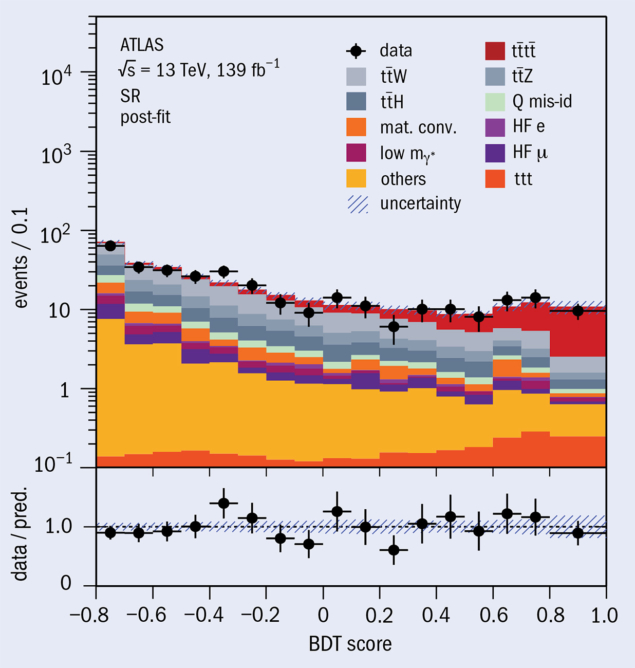A report from the ATLAS experiment

The production of four top quarks is an extremely rare event at the LHC, with an expected cross section five orders of magnitude below the production of a top-quark pair. With the heaviest elementary particle in the Standard Model produced four times in the final state, it is also one of the most spectacular processes accessible at the LHC. By combining two analyses, the ATLAS collaboration has uncovered the first strong evidence to support the existence of this unique event topology with sensitivity to theories beyond the Standard Model (BSM).
This is the only process that could probe potentially anomalous effective four-heavy-fermion operators

As a result of its large mass, the top quark plays a special role in numerous BSM theories, and many of these theories predict an increase in the four-top-quark production cross section. In particular, four-top-quark production is the only process that could probe potentially anomalous effective four-heavy-fermion operators. The cross section is also sensitive to the value of the top-quark Yukawa coupling, as a result of contributions mediated by Higgs bosons. However, until now, four-top-quark production has not been observed, in part because of its tiny production rate, and in part because the experimental signature of this process is very complex, requiring up to 12 particles to be reconstructed from the top-quark decays. The search is also affected by background sources in kinematic regions that are at the limit of the domain of validity of the simulations.
Despite these challenges, the ATLAS collaboration has recently released two studies of four-top-quark production using its full Run-2 data sample. The first study searches for events with two leptons (electrons or muons) with the same electric charge or with three leptons. This selection corresponds to only 13% of all possible four-top-quark final states, but is contaminated by only a small background, mainly from the production of a top-quark pair with a W, Z or Higgs boson and additional jets, or from events with one lepton with misidentified electric charge or a “fake” lepton that doesn’t correspond to a W or Z boson decay. Background processes were primarily simulated using the best available theoretical predictions; the rates of the most difficult ones were measured using control samples with similar properties to the signal events. The second study searches for events with one lepton or two oppositely-charged leptons. This selection retains 57% of the possible four-top-quark final states, but suffers from a large background from top-quark pairs produced in association with many jets, some of which are consistent with originating from b-quarks (b-jets). This background is difficult to model and was determined using data control samples. To better isolate the signal from the background, multivariate discriminants were trained in both analyses using distinct features of the signal, such as the number of b-jets and the kinematic properties of the reconstructed particles (see figure 1).

Results from the two studies were combined, leading to a four-top-quark cross-section measurement at 13 TeV of 25+7–6 fb, which is consistent with the Standard Model prediction of 12.0 ± 2.4 fb within 2.0σ (see figure 2). The statistical significance of the signal corresponds to 4.7σ, providing strong evidence for this process, close to the observation threshold of 5σ. LHC Run-3 data, possibly at a higher centre-of-mass energy, will allow ATLAS to verify whether the larger measured cross section relative to the prediction is confirmed or not.





